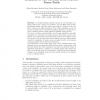Free Online Productivity Tools
i2Speak
i2Symbol
i2OCR
iTex2Img
iWeb2Print
iWeb2Shot
i2Type
iPdf2Split
iPdf2Merge
i2Bopomofo
i2Arabic
i2Style
i2Image
i2PDF
iLatex2Rtf
Sci2ools
SCIA
2007
Springer
2007
Springer
Estimation of Non-Cartesian Local Structure Tensor Fields
Abstract. In medical imaging, signals acquired in non-Cartesian coordinate systems are common. For instance, CT and MRI often produce significantly higher resolution within scan planes, compared to the distance between two adjacent planes. Even oblique sampling occurs, by the use of gantry tilt. In ultrasound imaging, samples are acquired in a polar coordinate system, which implies a spatially varying metric. In order to produce a geometrically correct image, signals are generally resampled to a Cartesian coordinate system. This paper concerns estimation of local structure tensors directly from the non-Cartesian coordinate system, thus avoiding deteriorated signal and noise characteristics caused by resampling. In many cases processing directly in the warped coordinate system is also less time-consuming. A geometrically correct tensor must obey certain transformation rules originating from fundamental differential geometry. Subsequently, this fact also affects the tensor estimation....
| Added | 09 Jun 2010 |
| Updated | 09 Jun 2010 |
| Type | Conference |
| Year | 2007 |
| Where | SCIA |
| Authors | Björn Svensson, Anders Brun, Mats T. Andersson, Hans Knutsson |
Comments (0)

